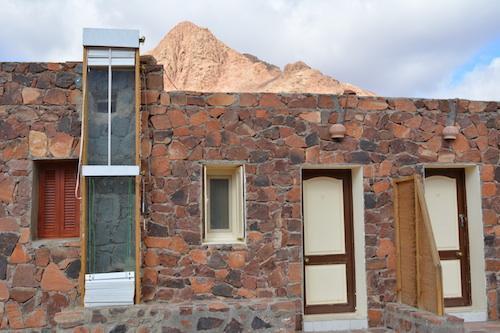WATCH AND EMBED VIDEO INTERVIEW WITH RESEARCHER MARWA DABAIEH: https://www.youtube.com/watch?v=J7_CtReM2O4
Researcher Marwa Dabaieh from Lund University in Sweden has come up with a way to adapt the so-called Trombe wall -- a passive solar building design from the 19th century -- to not only heat but also cool buildings, while drastically reduce associated carbon emissions. The new design is now being tested by locals in Saint Catherine, Egypt.
"In Egypt, fossil fuels account for 94% of all energy. There is therefore a great need for innovative energy solutions to reduce carbon emissions that can also be used in rural communities which do not always have electricity", says architectural researcher Marwa Dabaieh who divides her time between Lund University and the British University in Egypt.
 The Trombe wall ventilation system (to the left) has through a research project been modified to be used both for heating and cooling using renewable energy sources. Credit: Photo: Marwa Dabaieh / Lund University
The Trombe wall ventilation system (to the left) has through a research project been modified to be used both for heating and cooling using renewable energy sources. Credit: Photo: Marwa Dabaieh / Lund University
The vented Trombe wall is an old, yet still popular passive construction technique that hardly requires any energy. Marwa Dabaieh has continued to develop this technique so that it can be used for not only building heating, but also cooling -- providing a comfortable indoor temperature all year around.
"The new design uses renewable wind and solar energy to generate cooling and heating in buildings. The adjustments have also eliminated the original Trombe wall problem with overheating, which in turn has drastically reduced the total energy consumption and carbon emissions", says Marwa Dabaieh.
The new design has taken the aesthetic aspects of the Trombe wall into account, so that it can be integrated into modern buildings and become an attractive architectural element. The materials used to build the wall are local stone, wood and wool, as well as locally produced glass.
"Locals have been involved in every step of the process, so that they can easily build the Trombe wall themselves or show others how to construct one. Local construction could also help create new opportunities for young and unemployed people", says Marwa Dabaieh.
The villagers in Saint Catherine who have installed the Trombe wall have experienced a nicer indoor temperature, and several people have expressed a desire to have the new ventilation system installed; something Marwa Dabaieh sees as positive sign.
This passive ventilation system could be key for a sustainable future.
"In order to overcome future environmental challenges, we must invest in passive, low-cost systems that require almost no energy from fossil fuels. The vented Trombe wall has a great potential for meeting the steadily increasing energy demands without increasing carbon emissions", says Marwa Dabaieh.
source: Lund University